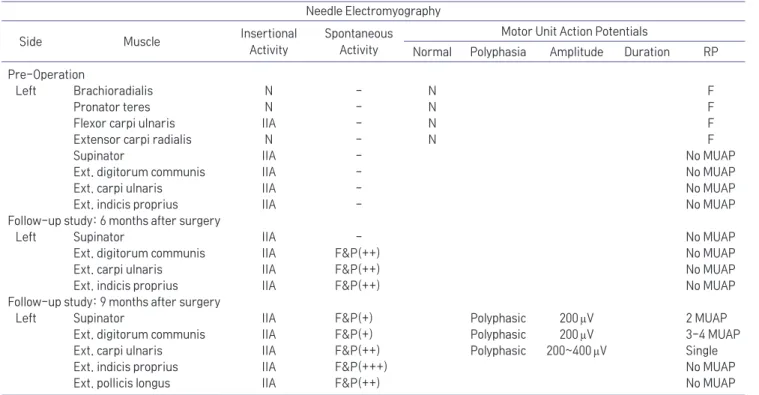Introduction
The posterior interosseous nerve (PIN) is a deep
branch of radial nerve, liable to compression. Compres- sion can occur spontaneously (entrapment) or second- ary to mass lesions (lipoma, ganglion). 1 The common entrapment sites are as followings: fibrous band of the radial head, radial recurrent vessels at the level of radial neck, extensor carpi ulnaris brevis, arcade of Frohse and distal part of supinator muscle. 1-3 Here we report a case of PIN neuropathy due to torsion of the nerve caused by compression of Leash of Henry, a recurrent branch of radial artery. Electrodiagnostic findings were
ISSN 1229-6066 https://doi.org/10.18214/jkaem.2019.21.1.32 J Korean Assoc EMG Electrodiagn Med 21(1):32-36, 2019
J Korean Assoc
Electrodiagn Med EMG
Copyright © by Korean Association of EMG Electrodiagnostic Medicine
This is an Open Ac cess article distributed under the terms of the Creative Commons Attribution Non-Commercial License (http://creativecommons.org/licenses/by-nc/4.0) which permits unrestricted non-commercial use, distribution, and reproduction in any medium, provided the original work is properly cited.
Received March 6, 2019 Revised April 17, 2019 Accepted May 10, 2019
Corresponding Author: Hee-Kyu Kwon
Department of Physical Medicine & Rehabilitation, Korea University Anam Hospital, 73 Goryeodae-ro, Seongbuk-gu, Seoul 02841, Korea
Tel: 82-2-920-6471, Fax: 82-2-929-9951, E-mail: hkkwon@korea.ac.kr
요골동맥의 압박에 의한 후골간 신경 비틀림과 그로 인한 신경병증: 증례 보고
이해인
1
, 김 단1
, 김동휘2
, 박종웅3
, 권희규1
고려대학교 1안암병원 재활의학과, 2안산병원 재활의학과, 3안암병원 정형외과
Posterior Interosseous Neuropathy Caused by Torsion due to Leash of Henry: A Case Report
Hae In Lee 1 , Dahn Kim 1 , Dong Hwee Kim 2 , Jong Woong Park 3 , Hee-Kyu Kwon 1
Departments of
1Physical Medicine & Rehabilitation,
3Orthopedic Surgery, Korea University Anam Hospital, Seoul,
2
Department of Physical Medicine & Rehabilitation, Korea University Ansan Hospital, Ansan, Korea
A 34-year-old man was referred for electrodiagnosis of left forearm and elbow pain with concurrent left wrist and finger extension weakness. Symptom developed abruptly, after waking up from sleep. After 11 days of onset, electromyography was performed. In nerve conduction study, the left radial motor response was unobtainable and in needle electromyography, abnormal spontaneous activities and no motor unit potential were noted in the left supinator, extensor digitorum communis, extensor carpi ulnaris and extensor indicis proprius muscles, suggesting left posterior interosseous neuropathy involving the supinator muscle and all the distal muscles to it. Subsequent ultrasonography of the left upper arm revealed multiple nerve torsions, and surgical exploration finally confirmed that the main torsion site was caused by the recurrent branch of radial artery, the Leash of Henry. We report an unusual case of spontaneous posterior interosseous nerve neuropathy due to nerve torsion caused by Leash of Henry.
